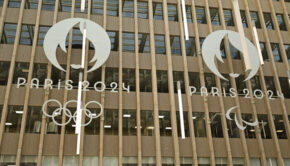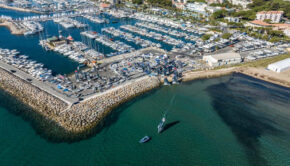Rio could be best sailing Olympic Games ever, but
Published on August 11th, 2014
American Morgan Reeser, a two-time 470 class Olympian and an Olympic silver medallist, has been equally successful as an Olympic coach for Greece and Great Britain. For the 2016 quad, he is working with Austria and USA, and here shares observations from the Olympic test event last week in Rio…
As stunning as was the sailing venue of the 2012 Olympics, with Dorset Cliffs and the mountain standing over Portland in the UK, the 2016 Rio Games and Guanabara Bay are absolutely breathtaking in every direction.
It is unfortunate for the event that water quality has been the dominant discussion in the press, and even more so that locals have to live with this condition every day. But when you are at the venue, all the negative talk about Rio goes away when you stop and take a look around at the amazing scenery all around you.
During the Aquece Rio – International Sailing Regatta 2014 on August 3-9, the 10 events were assigned to one of the five courses. Click here to view courses.
The 470 fleet has had the great pleasure (I am not sure they all appreciated it, but I did!) of sailing on the two offshore courses throughout the regatta. Because these race areas are so far away, and the winter race day is so very short, we get the chance to begin our sail/tow back to the marina as the sun sets behind mountain top “Christ the Redeemer” statue.
The sight of this 124-foot monument, with its arms stretched out widely, gave us all cause to consider our religious beliefs. A few kilometers later we pass the solemn darkness of Sugarloaf Mountain, and then into the twinkling lights all around Guanabara Bay.
But at the end of our 9 kilometer tow, arriving to the Marina Gloria at the end of the airport runway in the middle of downtown Rio, the madness begins.
Whatever religion we may have gained on our tow in, it is unfortunately lost with the consistently soul destroying decisions made by the organizers and race management at Olympic central in Marina Gloria. Course allocations and timing were poorly thought out and event communication to the athletes was intermittent and inconsistent. It all made for very long days with very few races to show.
The differences in sailing conditions among the five courses will be much greater than what the sailors experienced at the 2012 Games.
Wind is almost exclusively a 7-12 knot sea breeze that begins to fill at about 1200. It may fill on some courses at 1200 and never at all on other courses, depending on the day. The earliest racing had started was 1300, and no races could be started after 1615 because sunset is at 1730. It is a very short period to race, since it is winter in the Southern Hemisphere.
Rio is a very VERY busy port, and ships are held outside of bay between 1100 and 1730, so there is pressure on the race committee to have competitors back in the marina by 1730.
It is a very long tow from Marina Gloria to the two outside course areas. It is 8.8 kilometers to Niteroi course and 7.1 kilometers to Copacabana course, and we have normally been towing against a 1-1.5 knot tide going both directions.
The dominant theme offshore is the sea state. It is so rough that the newer ‘cutting edge’ Olympic classes such as the 49er skiffs, Nacra 17s and RS:X boards will probably never race out there. The wave conditions are so extreme that only the ‘old established classes’ such as the 470, Finn and Laser are seaworthy and safe enough to sail in Rio’s rough offshore courses.
The outside courses have big waves, even in very little wind. A 3 meter swell is quite common, and with the land to leeward on the Niteroi course, the massive swell bounces back onto the course, moving upwind to make the conditions even more uncomfortable, and unique. Tidal speeds offshore were up to 1.5 knots, and that was on a day with a small tidal change from high to low. For the sailors, it is very hard to find marks in the swell, while the race committee had a tough time anchoring marks and fighting motion sickness while on station.
The extreme contrast is the three inshore courses inside Guanabara Bay, which are lake-like but with lots of tide. They are all very close to Marina Gloria, with few if any waves, but a lot of geographical features. Each of the three inside courses has its own personality. They are highly changeable, most would say random, though sometimes overly predictable depending on the day and the course.
There is no doubt in my mind that Rio 2016 can be the best sailing Olympic Games ever, with challenging conditions on a number of very different course areas all surrounded by stunning scenery. The one thing that can detract from the great performances that we will see at Rio 2016 is the ever growing “over administration” of the Games by Olympic organizers and Race Managers.
Part Two discusses the impact of the administration on the Games and sailors.
Photos by Morgan Reeser of the offshore sailing areas.













 We’ll keep your information safe.
We’ll keep your information safe.